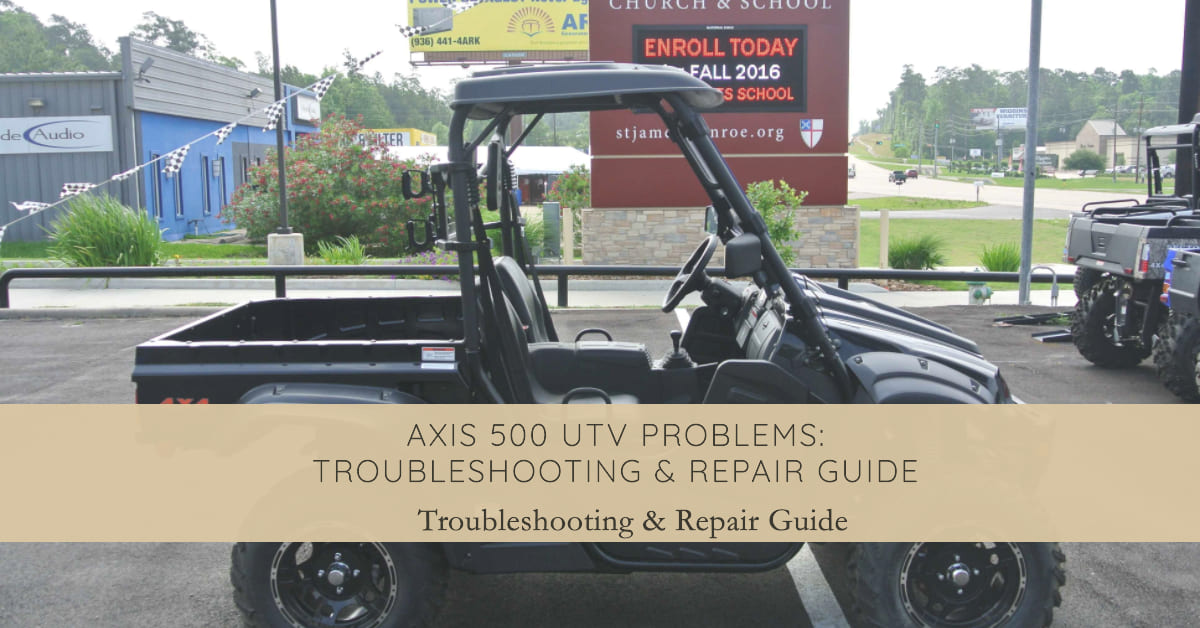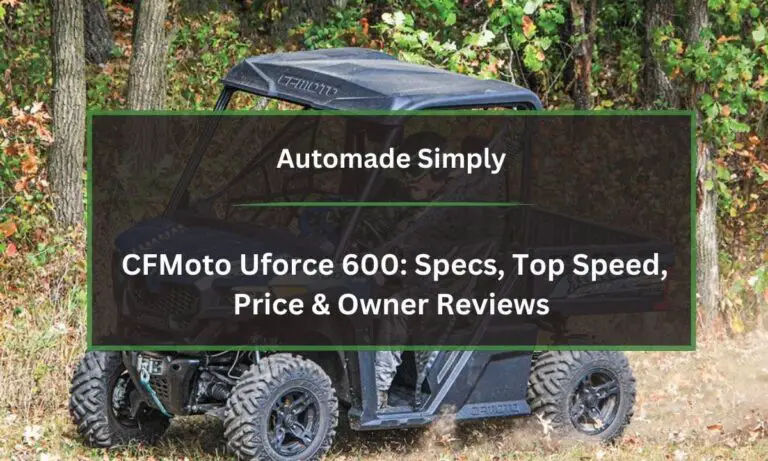Axis 500 UTV Problems: Troubleshooting & Repair Guide

The Axis 500 is one of the most popular recreational utility vehicles (UTVs) on the market today. With its powerful engine, smooth transmission, and rugged build, it’s built for off-road adventures. However, like any machine, the Axis 500 can develop issues over time that leave owners scratching their heads.
So what are the most common Axis 500 UTV problems, and how can you diagnose and repair them?
In short – Axis 500 problems typically involve the engine, electrical system, transmission, brakes, overheating, and minor issues like lights not working. Most problems can be fixed yourself with basic mechanical skills and a repair manual. Replacing fluids, filters, spark plugs, and making engine timing adjustments can restore performance. For more stubborn issues, troubleshooting components like the starter, alternator, and sensors will reveal the root cause.
This in-depth troubleshooting guide covers all the potential problems experienced by Axis 500 owners. We’ll discuss:
- Common engine problems and troubleshooting tips
- Electrical issues like battery drain and lighting faults
- Transmission and drivetrain problems
- Brake system repairs
- Overheating causes and solutions
- Safety recalls to be aware of
Properly maintaining your Axis 500 according to the recommended service schedule is key to minimizing issues. But when problems do arise, this guide will help you diagnose and fix them. Let’s get started!
Table of Contents
Introduction to the Axis 500 UTV
The Axis 500 UTV is manufactured by Axis Motors, a leader in heavy-duty utility vehicles. Introduced in 2010, it was designed from the ground up to deliver exceptional power and handling for recreation, farming, and rugged terrain.
Key features include:
- 500cc single-cylinder engine generating 50 HP
- On-demand true 4-wheel drive
- 1,500 pound towing capacity
- Hydrostatic transmission with high/low range
- Double A-arm independent front and rear suspension
- Disc brakes with hydraulic actuation
- Rugged steel body and chassis
- 2,000 pound payload capacity
The Axis 500 is popular with hunters, farmers, ranchers, and off-roading enthusiasts. It’s a great combination of power, reliability, and value. When maintained properly, the Axis 500 UTV can log hundreds of hours of use while requiring only basic upkeep.
However, they are complex machines and occasional issues can arise. The rest of this guide will cover the most common Axis 500 problems reported by owners and steps to diagnose and repair them.
Common Axis 500 Engine Problems and Solutions
The engine is the heart of any UTV. Axis 500 models are equipped with a 500cc single-cylinder engine mated to a hydrostatic transmission. It’s a relatively simple and robust powerplant. But with prolonged use, some key problems can develop. Let’s look at the most common engine issues and how to get your Axis 500 back up and running.
Axis 500 Won’t Start
Difficulty starting is one of the most common complaints from Axis 500 owners. There are a few key things to check if your engine won’t fire up:
Dead Battery
- Use a multimeter to test battery voltage. Should be 12.6+ volts when fully charged. Charge battery if low.
- Check battery cable connections. Clean any corrosion with a wire brush or baking soda solution.
- Consider replacing battery if over 3 years old. Cold weather reduces cranking power.
Faulty Starter
- Bypass starter relay by shorting terminals with a screwdriver. If starter engages, replace relay.
- Tap on starter motor while turning ignition. If it engages, starter is failing and needs replacement.
No Fuel
- Verify sufficient gas in tank and fuel shutoff valve is open.
- Check for clogs or pinches in the fuel line. Replace fuel filters.
- Make sure fuel pump is operating by listening for its hum when turning ignition. Replace if faulty.
Bad Spark Plugs
- Remove spark plugs and check for fouling or excessive wear. Replace plugs every 100 hours.
- Check plug gap against spec in owner’s manual. Gap to 0.7-0.8mm.
Axis 500 Overheating Issues
The Axis 500 liquid-cooled engine relies on the cooling system to maintain proper operating temperature. Overheating can lead to reduced power, engine damage, and smoky exhaust.
Low Coolant
- Visually check level in overflow tank when engine is cold. Top up with recommended coolant mixture if low.
- Look for leaks at hoses, radiator, water pump. Replace leaking components.
Faulty Radiator Fan
- Check fan blade spins freely. Remove debris blocking it.
- Verify fan turns on when engine gets hot. If not, test fan relay and circuit. Replace fan if still not operating.
Clogged Radiator
- Visually inspect radiator fins for dirt or debris blocking air flow. Carefully clean with compressed air or radiator brush.
- Severe clogs may require removing the radiator to rod out. Use radiator flush chemical to clear stubborn buildup.
Loss of Engine Power
Over time, the 500cc Axis engine can start to feel sluggish, especially when climbing hills or hauling heavy loads. Loss of power is often gradual. Here are a few maintenance items to improve performance:
Dirty Air Filter
- Check air filter element, replace if dirt is visible. Use genuine Axis part.
- Clean air box and inlet hose to prevent debris ingestion.
Clogged Fuel Injectors
- Run a bottle of fuel injector cleaner through a full tank of gas to clean injectors.
- If problem persists, injectors may need professional cleaning or replacement.
Engine Timing
- Inspect timing chain tensioner and guides for wear. Replace if loose.
- Verify camshaft and crankshaft timing marks are aligned per factory specs.
- Adjust valve lash clearance on the valves to 0.10mm-0.15mm inlet and 0.20mm exhaust.
Regular maintenance like air filter changes, fuel system treatments, and checking engine timing will minimize power loss. But if performance continues to decline, a compression test can check for piston ring wear or cylinder leakage. The Axis 500 engine may need an overhaul if compression is under factory spec.
Electrical System Issues on the Axis 500
The Axis 500 electrical system powers all the lighting, gauges, safety switches, and accessory plugs. Like most UTVs, there are a few common electrical issues to be aware of:
Lights Not Working
Running light bulbs can blow at any time. Check these items if one or more lights stop working:
- Inspect fuses – replace any that are visibly burned out. Use correct fuse ratings.
- Test light bulbs with a multimeter for opens. Swap in new bulbs as needed.
- Remove and inspect wiring harness connectors. Clean or replace corroded plugs.
- Use a circuit tester to verify power at light switch and trace wiring back to source.
Battery Not Charging
If the battery shows 12+ volts with engine off but drops to 10 or less volts running, the charging system isn’t working right.
Loose Alternator Belt
- Inspect alternator belt tension by pushing down mid-span. ~10mm deflection is ideal.
- Tighten or replace belt if loose. Consult owner’s manual for belt routing.
Battery Cable Corrosion
- Disconnect battery cables and clean any corrosion with a wire brush.
- Coat terminals with dielectric grease to prevent future corrosion.
Bad Alternator
- Use a multimeter to check alternator output while running – should show 13.5-15 volts.
- Test alternator diode trio with multimeter. Replace alternator if output is low or diodes faulty.
Accessory Power Issues
If onboard power outlets or winch/plow controls stop working, check these items:
- Reset circuit breakers in the fuse panel – overload can trip them.
- Inspect power switches and relays for damaged contacts. Test/replace as needed.
- Measure power at auxiliary switch panels. Trace wiring back to source if low/no voltage.
The Axis 500 has a rugged electrical system, but regular inspections will catch issues before they leave you stranded in the field. Carry spare fuses, relays, and a toolbox for trailside repairs.
Troubleshooting Axis 500 Transmission Problems
The Axis 500 uses a continuously variable transmission (CVT) optimized for low-speed torque and smooth shifting. The steel drive belt and clutches can wear over time, leading to performance issues:
Transmission Slipping
If engine revs freely without drive engagement, the belt may be worn or lubrication low:
- Check CVT fluid level and condition. Fluid should be clear – replace if discolored.
- Inspect belt for cracks, fraying or missing cogs. Replace if worn. Rebuild clutches if damaged.
Hard Shifting
Harsh or delayed shifts between gears indicates issues:
- Drain fluid and change filters per maintenance schedule. Use OEM filters and fluid.
- Check adjustment of clutch weights and driven pulley spring. Re-shim if out of spec.
- Check for binding shift lever. Lubricate shifter mechanism. Replace worn shift fork.
Protect your CVT by staying within the factory power limit and avoiding excessive mud or water ingestion. Changing fluid and filters regularly also extends transmission life.
But if problems persist, the belt, clutches or shafts may require overhaul by an authorized Axis repair shop for optimal performance.
Axis 500 Brake Problems and Repairs
Reliable braking is critical for controlling the Axis 500, especially when towing or descending hills. Let’s review the brake system and common issues:
Brakes Feel Spongy
Spongy brake pedal can indicate problems:
- Bleed brake system to purge any air – use brake bleeder tool for best results.
- Check master cylinder fluid level. Add DOT3 fluid if required. Replace any leaking seals or hoses.
Brakes Pull to One Side
Uneven braking can make steering difficult:
- Inspect pad thickness – uneven wear will cause pulling. Replace pads in pairs.
- Clean and lubricate caliper slider pins for smooth operation. Sticking pins causes uneven wear.
- If one rotor is excessively worn, resurface or replace in pairs to prevent grabbing.
Reduced Braking Power
Brakes that feel weak or need extra pedal effort to stop could have:
- Contaminated pads – clean rotors and replace pads if oil-soaked.
- Air in hydraulic lines – bleed system thoroughly to purge any air bubbles.
- Leaking wheel cylinders – seal kits are available to rebuild calipers and wheel cylinders.
The Axis 500 brake components are high quality but maintaining the system is essential. Flush fluid annually, check pad thickness, and look for fluid leaks. These simple steps minimize brake problems on the trail.
Why Does My Axis 500 Overheat?
Engine overheating is a serious issue that can lead to blown head gaskets, seized pistons, and other damage. Here are some common overheating causes on the Axis 500:
Insufficient Coolant
- Check overflow tank level cold – should be at “Full Cold” mark. Top off if low.
- Inspect hoses, radiator, water pump for leaks. Repair any issues and refill coolant.
Damaged Radiator
- Check for bent fins restricting airflow. Carefully straighten. Replace radiator if severely damaged.
- Remove debris like mud or dirt if clogged. Flush system to clear buildup.
Failing Water Pump
- Listen for pump noise/whine. Bearing wear allows coolant flow back. Replace faulty pump.
- Check belt tension driving pump. Re-tension or replace if loose.
Thermostat Stuck Closed
- Replace thermostat if engine takes long time to reach operating temperature. Stuck closed thermostat inhibits flow.
Head Gasket Leak
- White exhaust smoke, oil in coolant, or coolant loss indicates a bad head gasket. Requires cylinder head removal to replace gasket.
Overheating often results from multiple factors like old coolant, low fluid level, and crud buildup in the radiator restricting flow. Replacing all coolant hoses, flushing the radiator, and inspecting water pump condition is advised after any overheat incident. Proper cooling system maintenance prevents most Axis 500 overheating problems.
Axis 500 UTV Safety Recalls to Know About
Like most manufacturers, Axis has issued a few safety recalls over the years for the 500 model related to potential fire risks, loss of control, and crash hazards. Owners should be aware of the following recalls to get repairs completed:
Exhaust Shield Fire Hazard
Models impacted: 2010-2013 Axis 500
Issue: Exhaust heat shield can fall off, allowing hot exhaust to potentially ignite vegetation or cargo.
Fix: Dealer will install a wire-form heat shield to better withstand vibration.
Front Suspension Arm Fracture
Models impacted: 2010-2014 Axis 500
Issue: Lower front suspension arm may crack at the ball joint mounting point, increasing crash risk from loss of steering control.
Fix: Suspension arms replaced with reinforced versions.
CVT Clutch Bolt Failure
Models impacted: 2012-2015 Axis 500
Issue: Some CVT clutch bolt threads inadequate – can break and allow clutch to separate from engine. Lead to loss of drive power.
Fix: Dealer will replace clutch mounting bolt with upgraded bolt.
Checking for outstanding safety recalls is quick insurance to make sure your Axis 500 UTV stays reliable. The NHTSA website lets you search by VIN # to view applicable recalls. Get any necessary repairs done as soon as possible.
Conclusion
While the Axis 500 has proven itself as a rugged and dependable utility vehicle, ongoing maintenance and attention to minor issues will keep you off the trailside. Regular oil changes, tuning up the engine, and inspecting components for wear minimizes the chances of a breakdown miles from the nearest access road.
But if problems do pop up, use this troubleshooting guide to isolate the cause and make repairs. Whether it’s engine power loss, electrical gremlins, transmission slipping, or brake issues, we’ve outlined the likely culprits and solutions to get your Axis 500 back up and running quickly. Monitoring fluids, replacing filters per the service schedule, and cleaning debris from the cooling system will optimize performance and longevity.
We hope this overview of common Axis 500 UTV problems aids owners in completing basic repairs themselves or knowing when to seek expert help. Properly maintaining your Axis will lead to years of reliable service under even intense use conditions. Just be diligent about upkeep, troubleshoot issues promptly, and rely on quality OEM replacement parts for a smooth-running utility vehicle.







